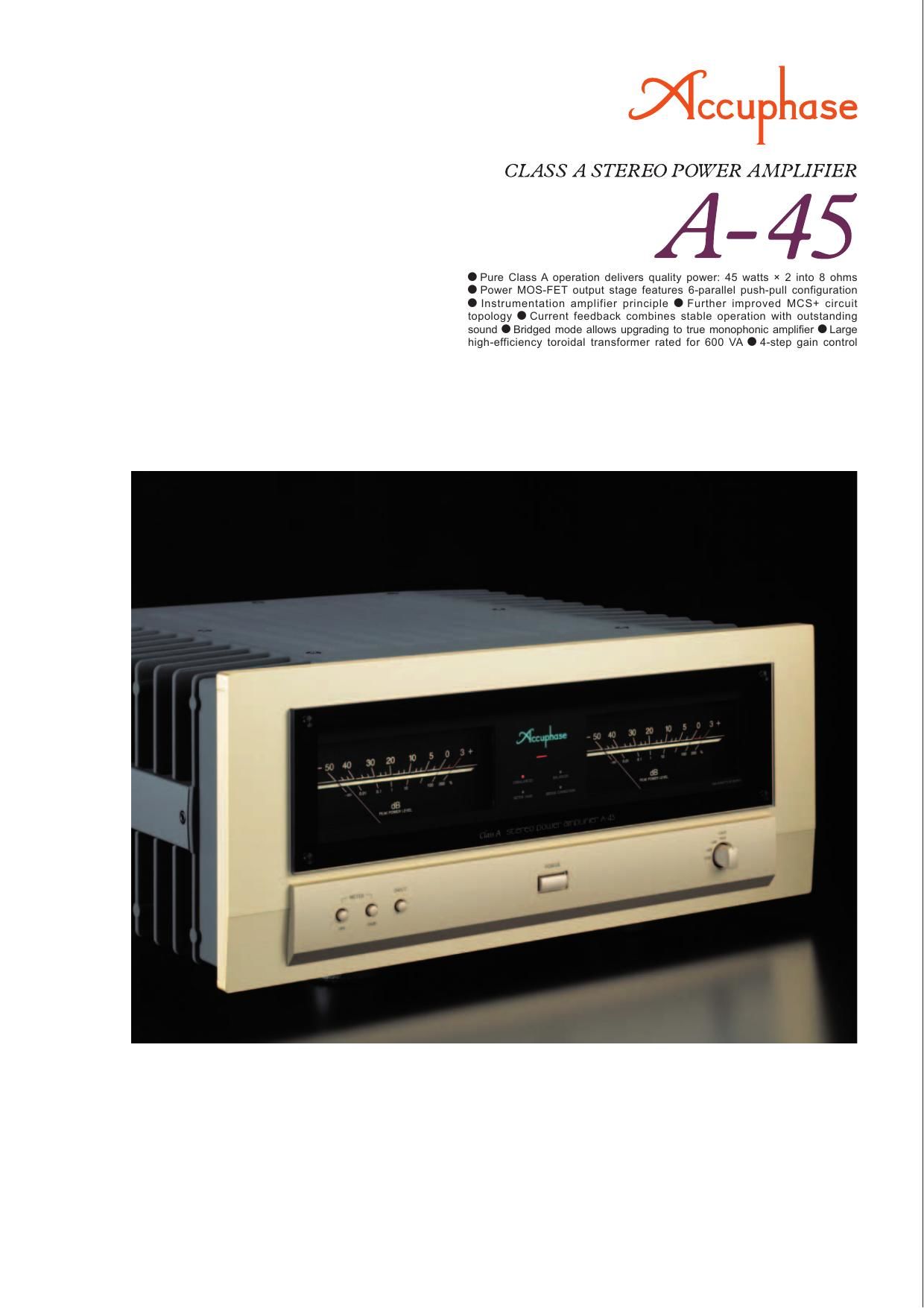Page 1
Bias stabilizer
circuit
Bias stabilizer
circuit
+INPUT
-INPUT
Bias stabilizer
circuit Bias stabilizer
circuit
Bias stabilizer
circuit
Pure Class A power ampliļ¬ er uses power MOS-FET devices to deliver 45
watts per channel (8 ohms) - Fully balanced signal paths as found in high-
quality instrumentation ampliļ¬ ers. Further reļ¬ ned MCS+ topology and
current feedback result in superb sound quality and excellent ratings for S/N
ratio, THD, and other parameters. Strong power supply and power MOS-
FET devices in six-parallel push-pull conļ¬ guration sustain an amazing 360
watts per channel into ultra-low impedance 1-ohm loads (with music signals).
Pure Class A power ampliļ¬ ers from Accuphase
have long been blending the purity of class
A operation with the superior performance of
power MOS-FETs. Acclaimed by audiophiles
the world over, these products reļ¬ ect a level
of technical know-how that is second to none.
Completing the A series lineup, the A-45 is ideal
for systems that demand not quite the high
power levels of the A-60 but require more power
than the A-30 provides. The A-45 of course also
demonstrates the same unwavering dedication
to sound quality and outstanding design policy
which are the hallmark of Accuphase. This pure
class A stereo power ampliļ¬ er with its distinctive
external heat sinks is built for the true enjoyment
of music.
The so-called instrumentation ampliļ¬ er principle
is used throughout. The signal handling stages
feature further improved MCS+ topology and
the renowned current feedback approach.
This results in electrical characteristics that
surpass even the demanding standards set
by its predecessors. Employing only highest
grade materials and strictly selected parts, the
A-45 realizes the two most important goals of
an ampliļ¬ er: very low output impedance and
constant drive voltage.
The output stage features power MOS-FETs
renowned for their excellent sound and supe-
rior reliability. For each channel, six of these
devices are arranged in a parallel push-pull
arrangement. Because MOS-FETs have
negative thermal characteristics, there is no
danger of thermal runaway as exists with
bipolar transistors. Operation remains totally
stable even when the ampliļ¬ er is running hot.
Driving these devices in pure class A assures
high-deļ¬ nition sound that brings out the ļ¬ nest
nuances in the music.
The heavy-duty power supply features a mas-
sive power transformer rated for a maximum
of 600 VA, plus two smoothing capacitors of
47,000 Ī¼F each. This easily sustains output
levels of as much as 360 watts per channel into
1 ohm (with music signals). If even higher power
is required, bridged mode turns the A-45 into a
high-grade monophonic power ampliļ¬ er.
n Power modules with 6-parallel push-pull arrangement of power MOS-FETs
deliver 360 watts per channel into 1 ohm (music signals only), 180 watts
into 2 ohms, 90 watts into 4 ohms, or 45 watts into 8 ohms.
n Amply dimensioned power supply with high-efficiency toroidal
transformer and large ļ¬ ltering capacity.
The high-efļ¬ ciency toroidal transformer is rated for 600 VA, and the two extra-
large 47,000 Ī¼F aluminum electrolytic capacitors were selected for best sonic
performance.
n Bridged mode allows upgrading to monophonic ampliļ¬ er with 720 watts
into 2 ohms (music signals only), 360 watts into 4 ohms, or 180 watts
into 8 ohms.
Bridged connection increases the output by a factor of 4, creating dramatic power
reserves in a monophonic conļ¬ guration.
n Four gain control settings minimize residual noise.
The gain control switches gain in the ļ¬ rst stage of the instrumentation ampliļ¬ er.
Four settings are available (MAX, -3 dB, -6 dB, -12 dB).
n Fully balanced input stage shuts out external noise interference.
n Mode selector for easy switching between dual mono/stereo/bridged
operation.
n PCB copper foil and all major signal path components are gold-plated.
n Large analog power meters with off switch and sensitivity selector.
n Oversize speaker terminals accept also Y lugs.
Toroidal power transformer
Filtering capacitors
Gain selector
Meter and input buttons
Power MOS-FETs
Large speaker terminals Parts selected for sound quality and reliability Assembly with meter and protection circuitryBalanced input connectors Gold-plated parts
�+ 1-ohm operation possible with music signals only Output voltage (V)
Fig. 2 Load impedance vs. output power (output voltage/output current) Fig. 1 Circuit diagram of ampliļ¬ er section (one channel)
Output current (A)
MCS+ (Multiple Circuit Summing-up)
Instrumentation ampliļ¬ er
Power MOS-FETs
6-parallel push-pull Gain control
Page 2
I-V
converter Amplifie
Current NFB
network Trans-impedance
amplifie Current
adder - Input
+ Input
Output Buffer
Buffer
Instrumentation amp conļ¬ guration allows
fully balanced signal paths
The newly adopted instrumentation amplifier
principle ensures that all signal paths from the
inputs to the power amp stage are fully bal-
anced. This results in excellent CMRR (common
Current feedback principle assures excel-
lent phase characteristics in high range
As shown in the illustration, the A-45 uses the
output signal current rather than voltage for
feedback. Since the impedance at the current
feedback point is very low, there is almost no
phase shift. A minimal amount of NFB therefore
results in maximum improvement of circuit
parameters. mode rejection ratio) and minimal distortion.
Another significant advantage is that external
noise and other external influences are virtually
shut out. The result is a drastic improvement in
operation stability and reliability.
Further reļ¬ ned MCS+ topology for even
lower noise
Accuphases original MCS (Multiple Circuit
Summing) principle uses a number of identical
circuits connected in parallel to achieve superior
performance characteristics. MCS+ is a further
refined version of this approach. By extending
parallel operation to the class-A drive stage of
the current/voltage converter, the noise floor
has been lowered further.
n Power ampliļ¬ er assemblyPower amplifier assembly
with six parallel push-pull
power MOS-FET pairs per
channel mounted directly to
large heat sink, MCS+ cir-
cuitry, and current feedback
ampliļ¬ er.
Instrumentation ampliļ¬ er conļ¬ guration
Signal input stage Power ampliļ¬ er stage
+ INPUT
- INPUT
Instrumentation ampliļ¬ er and further reļ¬ ned MCS+ topology
Principle of current feedback ampliļ¬ er

